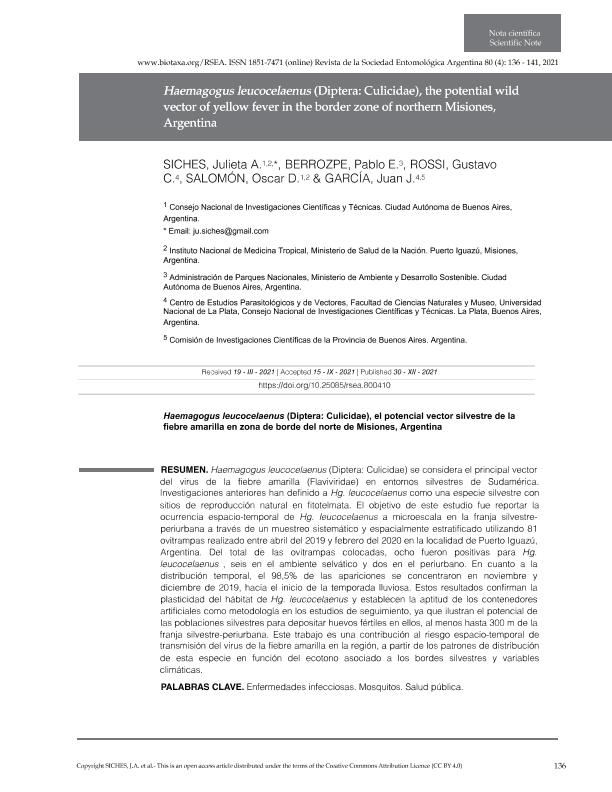Artículo
Haemagogus leucocelaenus (Diptera: Culicidae) is considered the primary vector of yellow fever virus (Flaviviridae) in wild environments in South America. Previous research has defined Hg. leucocelaenus as a wild species with phytotelmata-type breeding sites. The objective of this study was to report the temporal and space occurrence of Hg. leucocelaenus at the microscale in the wild-periurban fringe through a systematic and spatially stratified sampling using 81 ovitraps between April 2019 and February 2 020 in the locality of Puerto Iguazú, Argentina. Of the total ovitraps, eight were positive for Hg. leucocelaenus, six in the wild environment and two in the periurban environment. Regarding the time distribution, 98.5% of the occurrence was concentrated in November and December 2019 towards the beginning of the rainy season. The results confirm the habitat plasticity of Hg. leucocelaenus and establish the aptitude of artificial containers as a methodology in monitoring studies, since they illustrate the potential of wild populations to deposit fertile eggs in them at least up to 300 m from the wild-periurban fringe. This work is a contribution to determine the temporal and space risk of yellow fever virus transmission in the region, based on the distribution patterns of this species as a function to the ecotone associated with forest borders and climatic variables. aemagogus leucocelaenus (Diptera: Culicidae) se considera el principal vector del virus de la fiebre amarilla (Flaviviridae) en entornos silvestres de Sudamérica. Investigaciones anteriores han definido a Hg. leucocelaenus como una especie silvestre con sitios de reproducción natural en fitotelmata. El objetivo de este estudio fue reportar la ocurrencia espacio-temporal de Hg. leucocelaenus a microescala en la franja silvestreperiurbana a través de un muestreo sistemático y espacialmente estratificado utilizando 81 ovitrampas realizado entre abril del 2019 y febrero del 2020 en la localidad de Puerto Iguazú, Argentina. Del total de las ovitrampas colocadas, ocho fueron positivas para Hg. leucocelaenus , seis en el ambiente selvático y dos en el periurbano. En cuanto a la distribución temporal, el 98,5% de las apariciones se concentraron en noviembre y diciembre de 2019, hacia el inicio de la temporada lluviosa. Estos resultados confirman la plasticidad del hábitat de Hg. leucocelaenus y establecen la aptitud de los contenedores artificiales como metodología en los estudios de seguimiento, ya que ilustran el potencial de las poblaciones silvestres para depositar huevos fértiles en ellos, al menos hasta 300 m de la franja silvestre-periurbana. Este trabajo es una contribución al riesgo espacio-temporal de transmisión del virus de la fiebre amarilla en la región, a partir de los patrones de distribución de esta especie en función del ecotono asociado a los bordes silvestres y variables climáticas.
Haemagogus leucocelaenus (Diptera: Culicidae), the potential wild vector of yellow fever in the border zone of northern Misiones, Argentina
Título:
Haemagogus leucocelaenus (Diptera: Culicidae), el potencial vector silvestre de la fiebre amarilla en zona de borde del norte de Misiones, Argentina
Siches, Julieta Ailen ; Berrozpe, Pablo Eduardo
; Berrozpe, Pablo Eduardo ; Rossi, Gustavo Carlos
; Rossi, Gustavo Carlos ; Salomón, Oscar Daniel
; Salomón, Oscar Daniel ; Garcia, Juan Jose
; Garcia, Juan Jose
 ; Berrozpe, Pablo Eduardo
; Berrozpe, Pablo Eduardo ; Rossi, Gustavo Carlos
; Rossi, Gustavo Carlos ; Salomón, Oscar Daniel
; Salomón, Oscar Daniel ; Garcia, Juan Jose
; Garcia, Juan Jose
Fecha de publicación:
12/2021
Editorial:
Sociedad Entomológica Argentina
Revista:
Revista de la Sociedad Entomológica Argentina
ISSN:
0373-5680
e-ISSN:
1851-7471
Idioma:
Español
Tipo de recurso:
Artículo publicado
Clasificación temática:
Resumen
Palabras clave:
INFECTIOUS DISEASE
,
MOSQUITOES
,
PUBLIC HEALTH
Archivos asociados
Licencia
Identificadores
Colecciones
Articulos(CCT - NORDESTE)
Articulos de CTRO.CIENTIFICO TECNOL.CONICET - NORDESTE
Articulos de CTRO.CIENTIFICO TECNOL.CONICET - NORDESTE
Articulos(CEPAVE)
Articulos de CENTRO DE EST.PARASITOL.Y DE VECTORES (I)
Articulos de CENTRO DE EST.PARASITOL.Y DE VECTORES (I)
Citación
Siches, Julieta Ailen; Berrozpe, Pablo Eduardo; Rossi, Gustavo Carlos; Salomón, Oscar Daniel; Garcia, Juan Jose; Haemagogus leucocelaenus (Diptera: Culicidae), the potential wild vector of yellow fever in the border zone of northern Misiones, Argentina; Sociedad Entomológica Argentina; Revista de la Sociedad Entomológica Argentina; 80; 4; 12-2021; 136-141
Compartir
Altmétricas



